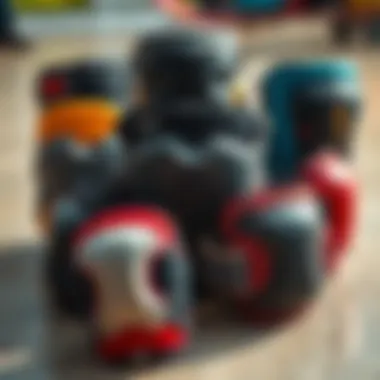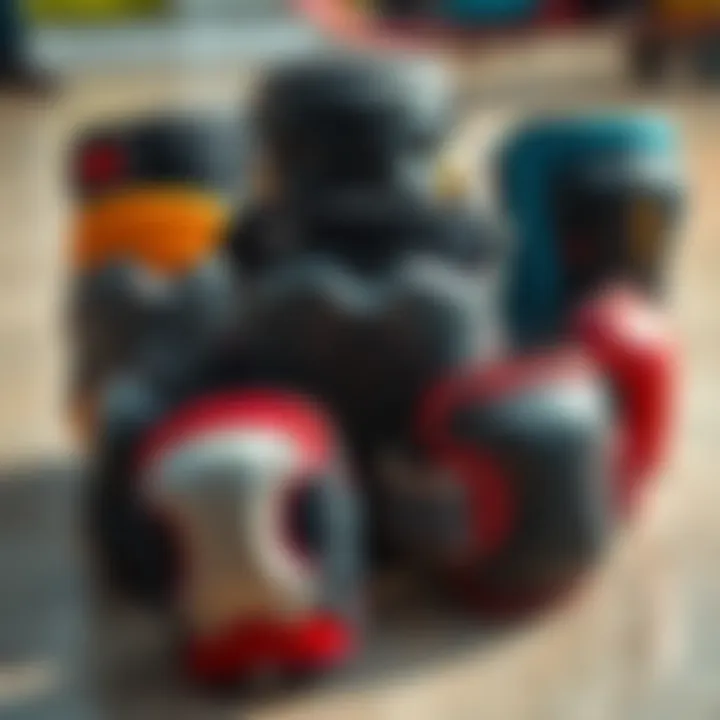Essential Guide to Skating Pads for Safe Skateboarding


Intro
Skateboarding is not just a thrilling pastime; it's a vibrant culture that embraces creativity and personal expression. However, behind the awe of flipping tricks and grinding rails lies an essential component that every skateboarder should prioritize: safety gear. In this guide, we will delve into the world of skating pads, the unsung heroes of skateboarding safety. These pads work tirelessly to protect the body's fragile areas, ultimately enabling skaters to push their limits without the fear of injury.
In this exploration, we will cover various types of skating pads, including knee, elbow, and wrist pads, and discuss their roles in preventing injuries, enhancing performance, and improving confidence on your board. From basic insights on gear selection to an overview of new material technologies, this guide is designed for everyone—from a novice finding their footing to seasoned pros seeking the latest in safety wear.
Understanding the significance of each type of pad can help you make informed choices that align with your skating style and personal preferences, ultimately elevating your skateboarding experience. With this guide, you'll be well-armed with knowledge, ready to ride comfortably and safely, no matter where the pavement takes you.
Preface to Skating Pads
In the realm of skateboarding, one cannot overstate the crucial role of skating pads. These protective gears serve not just as mere accessories; they are essential in safeguarding the bodies of skaters from the inevitable spills and falls that accompany this thrilling sport. When a skater takes to the board, the risks are palpable—injuries can range from minor scrapes to severe impact wounds. Therefore, having the right skating pads is not only a matter of safety but also a key factor in a skateboarder’s performance and lifespan in this demanding activity.
The importance of skating pads can be encapsulated in several key areas:
- Injury Prevention: These pads absorb impact, reducing the chances of fractures or strains, particularly in areas like the knees and elbows that are often prone to injury during skating.
- Confidence Building: Knowing that you’re protected allows skaters, particularly novices, to push their limits without the fear arising from potential injuries. It’s easier to learn new tricks when the fear of painful falls is mitigated.
- Cultural Acceptance: Wearing pads can sometimes signify a professional attitude toward the sport. In various skateboarding communities, they are seen as a badge of honor, reflecting a commitment to both safety and skill enhancement.
Ultimately, skating pads become an integral part of a skater's arsenal. As with any other gear, the choice of pads rightly deserves attention not only from safety perspectives but also from performance-enhancing angles.
Understanding the Importance of Safety Gear
When it comes to skateboarding, the right safety gear can be as vital as the skateboard itself. While some may think that safety gear is just for beginners or the overly cautious, the reality is that every single skateboarder, regardless of experience, can benefit immensely from wearing pads. Safety gear, particularly skating pads, is tailored to protect various parts of the body that are most likely to sustain injuries.
Take a trip to a skatepark, and you’ll likely see seasoned pros donning elbow and knee pads alongside their gear. This isn’t merely for show; each twist, turn, and jump that these skaters execute can lead to tumbles, and having that layer of protection can make the difference between a minor bruise and a serious injury. The trusted safety gear plays a vital role in not only preventing physical harm but also in fostering a positive mindset. Thus, a well-rounded understanding of safety gear is essential for skaters of all levels, as it directly influences their overall performance and willingness to progress in their skills.
Historical Context of Skating Pads
The evolution of skating pads can be traced back to the very roots of skateboarding itself. In the early days, skateboarding was predominantly an activity born out of surfing culture in California, where safety gear was little more than an afterthought. Back then, skaters often took to the streets with little more than their boards and a carefree spirit, making the risks elemental to the sport.
It wasn’t until the late 1970s and early 1980s, as skateboarding surged in popularity, that safety gear started gaining traction. Pioneers in the sport began noticing a spike in injuries and, with it, the necessity of protective gear became evident. Companies started manufacturing skating pads using high-density foam and hard plastic, aimed at reducing the impact of falls.
- 1980s Revolution: The introduction of kneepads and elbow pads saw new designs and materials. Skaters began to embrace pads, leading to a cultural shift in how skating was perceived. No longer a reckless endeavor, it became a sport that emphasized safety.
- Modern Developments: Today, skating pads are more advanced than ever, with innovations that provide not only superior protection but also enhanced comfort and flexibility. Straps and breathable materials have drastically improved their usability, making them a standardized piece of gear for skaters worldwide.
Understanding this historical context allows current and aspiring skaters to appreciate the importance of these pads that have evolved into essential safety equipment in an activity that continues to capture the imagination of many.
Types of Skating Pads
When it comes to skateboarding, the right type of skating pads can be the difference between a minor bump and a significant injury. Each type of pad serves a specialized purpose, designed to protect various parts of the body that are commonly at risk during skateboarding activities. Navigating the landscape of skating pads is crucial for both beginners and seasoned skaters alike—whether you're trying to master a new trick or simply take on the ramps. Below, we delve into the various types that are indispensable in ensuring safety on the board.
Knee Pads: Anatomy and Functionality
Knee pads are often seen as the frontline of defense in skateboarding. Their structure generally consists of a hard outer shell and soft inner padding, designed to absorb the impact of falls.
- Design Considerations: The knee pads typically wrap around the knee, featuring straps or Velcro closures for a snug fit. This ensures that they stay in place during intense skating sessions while allowing for a full range of motion.
- Functionality: The primary role of knee pads is to shield the knee joint from abrasions and impacts during falls. Given that knee injuries can lead to long-term issues, these pads play a vital role in extending a skater’s ability to ride without fear of serious injury.
Knee pads are particularly beneficial for street skaters, who encounter hard surfaces and obstacles. Additionally, the mental comfort that comes with wearing knee pads can boost confidence, resulting in better performance.
Elbow Pads: Protecting a Vulnerable Area
Along with the knees, elbows are another common injury site. Elbow pads are designed with similar features as knee pads but are generally more contoured to fit the joint. Their unique shape follows the elbow's natural curve, promoting both protection and flexibility.
- Crash Protection: When a skater falls, it's instinctive to brace oneself using the arms. Elbow pads prevent abrasions and blunt trauma that can cause abrasions or fractures in severe cases.
- Lightweight Options: Recent trends show a move towards lighter-weight materials, offering skaters protection without the bulk. This allows for comfortable wear throughout the skating session.


Elbow pads are not just for novices; they're essential for anyone trying to push their limits in skateboarding.
Wrist Guards: The Importance of Wrist Safety
Wrist guards stand out as perhaps the most critical piece of gear in a skater's safety arsenal. Injuries to the wrist can happen with alarming frequency, especially when performing flips and jumps.
- Design Features: Good-quality wrist guards often include splints, which help immobilize the wrist while providing cushioning. This immobilization protects against hyperextension and fractures that can occur during falls.
- Ergonomic Fit: They are normally designed to allow flexibility in the fingers, ensuring the skater can grip the board while still getting the necessary support.
By using wrist guards, skaters can focus on their performance rather than their safety, making them a staple for anyone serious about the sport.
The Role of Shin Guards in Skating
While knee and elbow pads are quite commonplace, shin guards are often overlooked. They are essential for those practicing tricks and can help prevent injuries caused by board impacts or falls.
- Protection from Board Impact: Skaters are prone to strikes from their boards, especially during tricks. Shin pads minimize the risk of bruises or lacerations.
- Comfort in Movement: They are designed to fit snugly without hindering movement, allowing skaters to ride freely while being protected.
Skating with shin guards is particularly advisable for those interested in aggressive skating or park environments.
Innovative Designs in Skating Pads
Beyond traditional designs, the world of skating pads has seen significant innovations that cater to an evolving skate culture. These cutting-edge designs focus on not just protection but also performance enhancement.
- Smart Padding Technologies: Some modern pads use materials that adapt to impacts, becoming harder upon contact to diffuse energy—perfect for those intense moments.
- Fashion Meets Function: Skaters are now seeking pads that align with their personal style. Many brands create visually appealing pads without compromising on safety, blending aesthetics with functionality.
By embracing these innovations, skaters can represent their individuality while prioritizing their safety. All these aspects culminate in one conclusion: the types of skating pads significantly impact a skater’s experience and performance.
Materials and Technology in Skating Pads
In the realm of skateboarding, safety and performance go hand in hand. The materials and technology that underpin skating pads are not just details; they play a pivotal role in the overall experience of the rider. Understanding these elements is crucial for anyone involved in the sport—from beginners to seasoned skateboarders and industry professionals alike. This section explores various materials, the advancements in padding technology, and how these choices influence performance on the board.
Common Materials Used in Skating Pads
To comprehend the protective capabilities of skating pads, one must first grasp the materials that comprise them. Generally, skating pads are constructed from a combination of several key materials:
- Foam: This is perhaps the most dominant material found in skating pads. It provides cushioning and absorbs impact, helping to prevent injuries. The density and type of foam can greatly affect comfort and protection levels.
- Plastic and Composite Shells: These rigid exteriors offer a crucial layer of protection against abrasions and impact. They are often designed to be lightweight and durable, ensuring that they don’t hinder movement.
- Neoprene and Lycra: These stretchy materials help the pads fit snugly against the body without limiting flexibility. They allow for a certain degree of comfort while also maintaining a secure fit, which is crucial during intense tricks.
- Velcro Straps: Often overlooked, these are essential for securing the pads in place. A good strap system can make or break a pad’s functionality; if it’s loose, protection can be compromised.
Each material brings its own strengths and weaknesses to the table. Skateboarders should understand how these components work together to ensure they select pads that align with their style of skating and the type of protection needed.
Advancements in Padding Technology
The world of skating pads is not stagnant; it’s dynamic and constantly evolving. Recent advancements in padding technology have pushed the boundaries of what these protective gears can offer:
- D3O Technology: This impressive material is soft and flexible but hardens upon impact, absorbing shock effectively. Pads incorporating D3O can significantly increase a rider's protection level without sacrificing flexibility.
- Moisture-Wicking Fabrics: Traditional pads can become hot and sweaty, leading to discomfort during long sessions. Newer materials that wick moisture away keep riders dry and comfortable, which is particularly beneficial for extended periods on the board.
- Custom Molding Options: Some brands now offer custom-fit pads that mold to the user’s body shape, providing personalized comfort and enhanced protection. This not only improves protection but also enhances performance, as riders can move more freely.
- Integrated Impact Sensors: Though still emerging, some cutting-edge pads are beginning to utilize technology that informs skaters of impacts sustained during tricks. This feedback can facilitate greater awareness of the risks associated with specific maneuvers.
These advancements not only enhance safety but also provide skateboarders with confidence, allowing them to push their limits further.
How Material Choices Affect Performance
The choice of materials in skating pads can significantly influence performance in various ways:
- Weight and Mobility: Heavier pads may provide more protection, but they can hinder a skater's mobility. A good balance between weight and protection can enhance a rider's overall performance, allowing them to execute tricks without feeling bogged down.
- Breathability: If the pads are not breathable, they can lead to overheating and discomfort, ultimately affecting focus and performance. Riders who can maintain a comfortable temperature will likely ride better and longer.
- Durability vs. Comfort: There is always a trade-off between how long the pads will last versus how comfortable they are. For instance, pads with thick protection might last longer but could feel bulky, while lighter pads are comfortable yet might need to be replaced sooner.
- Fit and Securement: Pads that don’t fit well can shift during use, exposing the rider to unnecessary risks. Properly fitting and secured pads enable skaters to fully concentrate on their tricks without the distraction of adjusting their gear.
In essence, the marriage between materials and their design in skating pads influences both protection and performance. Shots at new tricks or challenging yourself on difficult terrain can require one’s full attention. Therefore, investing time in understanding these choices will pay off in a safer and more enjoyable skating experience.


As the skating community continues to grow, the innovations in materials and technology pave the way for safer day-to-day adventures on the board.
Benefits of Wearing Skating Pads
Skating pads have become a critical element in the safe and enjoyable usage of skateboards. The benefits they offer span from preventing injuries to boosting a skater's confidence. Without these protective gears, skateboarders risk significant harm, especially when attempting tricks or navigating rough terrain.
Injury Prevention Strategies
When it comes to skating, falls are an inevitable part of the experience. Wearing skating pads significantly reduces the likelihood of injuries. Specifically, knee pads can absorb impact energy when a skater hits the ground, protecting the joint from bruises and fractures. Elbow pads serve a similar purpose, safeguarding not just the bone but also the skin from abrasions.
For practical safety strategies, it's essential to:
- Select the correct size: Pads that are too loose will shift during a fall, and those that are too tight can restrict movement.
- Choose well-constructed options: Look for high-density foams and durable exteriors that can withstand wear and tear.
- Practice falls safely: Understanding how to fall correctly can also minimize injuries, and wearing pads is part of that strategy.
In essence, skating pads act like insurance—tomorrow’s safety is much brighter when today’s precautions are taken.
Enhanced Confidence Through Protection
Skaters, especially those who are just starting, often have a certain apprehension about falling. This fear can hinder their progress and enjoyment of the sport. Wearing skating pads instills a sense of security, allowing skaters to focus on their skills without the constant worry of potential injuries.
The psychological advantage of protection cannot be overstated:
- Freedom to Explore: When skaters know their knees, elbows, and wrists are protected, they tend to push their limits. This leads to greater experimentation with tricks and styles.
- A Safer Environment: Skaters who wear pads convey a message to their peers that safety is a priority, further fostering a culture of protection within skating communities.
- Reducing Anxiety: This reduction in anxiety from a potential fall allows for a more enjoyable skateboarding experience, fostering a better relationship with the sport.
Impact on Learning New Tricks
Skating pads can significantly influence a skater’s ability to master new tricks. Each attempt at a new maneuver carries the risk of falling, and without adequate protection, many skaters may hesitate to pursue progress.
The benefits for learning new tricks include:
- Encouraged Risk-Taking: With pads in place, learners are more inclined to take the plunge into tricks that previously felt too risky.
- Faster Skill Acquisition: A safer environment enables skaters to practice more frequently and try challenging tricks without fear holding them back.
- Recovery from Falls: Easier falls, cushioned by gear, lead to quicker recoveries, allowing skaters to get back on their boards without as much downtime.
In short, skating pads serve not only as protective gear but as a means to advance a skater's abilities and confidence, ultimately enriching the skateboarding experience.
"Protective gear doesn’t just shield the body; it frees the mind to ride the board to its full potential."
Choosing the Right Skating Pads
Selecting the appropriate skating pads is not just a matter of personal preference; it's an essential aspect of ensuring safety while skateboarding. With the vast array of options available today, understanding the practical elements and benefits of each type of pad can significantly affect both performance and injury prevention. Good pads are seldom a luxury but rather a necessary investment for any serious skater. Choosing wisely means looking at sizing, material quality, and even personal style, all of which can enhance your overall skateboarding experience.
Sizing and Fit Considerations
When it comes to skating pads, fit is paramount. Ill-fitting pads can negate their protective capabilities. Get them too snug, and you risk hindering your movement and blood circulation; too loose, and they may shift during a fall, offering insufficient protection. To find your ideal size, take measurements around the specific areas where the pads will sit. For knee pads, this would be the circumference of the knee; for wrist guards, it's the wrist itself. Most brands provide size charts, so referring to these can help you nab the right match.
In addition to size, consider the shape and padding thickness. Some skaters prefer a low-profile, snug fit, while others might go for thicker, bulkier designs. Try on different styles and give them a test spin, if you can. Precaution can save a world of pain, and something as simple as getting the right size should never be overlooked.
How to Assess Quality and Durability
Quality and durability are two critical elements when browsing for skating pads. Take a good look at the stitching, material, and overall design. Are the straps sturdy? Is the foam densely packed? Well-constructed pads often feature double stitching, which adds a layer of durability.
Testing the padding by physically pressing against it (without crushing them) can give you insight into how well they might absorb impacts. Furthermore, look for pads that boast protective features such as reinforced outer shells or moisture-wicking fabrics. These elements can contribute to a longer shelf life, ultimately saving you money in the long run.


Personal Preferences in Style and Design
While safety is undoubtedly the focus, personal style shouldn't be pushed aside. Pads come in various designs, colors, and finishes, allowing you to express who you are on the board. Some skaters lean towards sleek, minimalist designs while others prefer bold, standout aesthetics.
Reflect on what resonates with your personal skating vibe. Some brands might offer customizable options, giving you the ability to choose color combinations or graphics. A well-matched set can make you feel more equipped to tackle that next grind or ollie, boosting both your confidence and enjoyment.
Incorporating your personal flair not only makes you look good but also keeps you motivated to skate. Whether you’re chilling at the park or busting out moves on the street, the right pads will blend functionality with personal expression.
Remember, the right skating pads serve to protect you while enabling you to bring your unique style to life. Don’t settle for less—prioritize safety and self-expression in equal measure.
Common Myths About Skating Pads
When it comes to skating, the dialogue surrounding protective equipment often sways into the territory of myth and misconception. Addressing these misunderstandings is crucial, especially given the direct link between safety gear and the well-being of skateboarders. Without a doubt, the importance of accurately understanding skating pads cannot be overstated. Misinformation can lead to injurious attitudes, ultimately compromising one’s riding experience. In this section, we’ll take a closer look at two pervasive myths that circulate among the skateboarding community, clarifying their origins and truths.
Misconceptions About Comfort
A common misconception about skating pads is that they are bulky and uncomfortable, leading to a constraining feel while skating. Many enthusiasts are worried that wearing pads will limit mobility and make them feel clumsy. It’s similar to the old saying, "You can’t have your cake and eat it too." What this boils down to is that comfort and protection are often seen as opposing forces.
However, this perception doesn’t align with current innovations in skate padding. Skate pads today can be surprisingly lightweight and flexible but still offer robust protection. For example, many brands make use of materials like EVA foam, which molds to the shape of one’s body while absorbing impact. This design not only aids in comfort but also enhances mobility.
Additionally, there are varieties of pads tailored specifically for different riding styles and preferences, ensuring there’s something available that feels right. It’s important for skateboarders to try on multiple options and find what works best for their unique needs. Addressing comfort is more than just a luxury; it plays a vital role in a rider’s confidence to attempt new tricks or challenge themselves on the board.
"Comfort is not just a bonus, it’s an essential part of riding safely and effectively," according to a community discussion on reddit.com.
Debunking the ‘Pads are for Beginners’ Mentality
Another myth that lingers in skate culture is the belief that wearing pads signifies a lack of skill or experience. This attitude often stems from a misguided bravado where seasoned skaters equate injuries and risk-taking with genuine prowess. The notion that 'only beginners wear pads' is a disservice not only to the equipment but also to the growth and safety of skaters at all levels.
The reality is that the most experienced skateboarders often prioritize safety gear as a way of preserving their skills for longer periods. A seasoned skater, who frequently takes on high-risk tricks, understands that accidents happen. As the phrase goes, "It’s better to be safe than sorry." Wearing pads, regardless of one’s skill level, is not an indication of weakness; rather, it signifies a sensible approach to a sport that inherently involves risks.
In recent years, prominent skaters have become vocal advocates for protective gear. They’ve demonstrated that style and safety can coexist, moving to shift the cultural narrative surrounding skating pads. Their influence serves as a reminder that every rider, regardless of their experience, should feel empowered to wear pads for their protection.
Cultural Significance of Skating Pads
Understanding the cultural significance of skating pads is essential, as it gives deeper insights into how skateboarding as a sport is juxtaposed with safety practices. Skating pads aren’t just protective gear; they have become a symbol of a community’s evolving attitudes towards safety and style. They represent a shift from reckless abandon to mindful practice, contributing not just to individual safety but also to the collective identity of skateboarders.
The Evolution of Attitudes Toward Safety Gear
In the early days of skateboarding, notably the 1970s and 80s, the culture was largely about the thrill, freedom, and the raw edge of the sport. Most skateboarders viewed safety gear, particularly pads, as something that hindered their style and perhaps even their
Culmination and Future of Skating Pads
As we wrap up our exploration of skating pads, it becomes clear that these protective gears play an essential role in enhancing skateboard safety and performance. They are not just mere accessories; their importance is underscored in every skate session. From cushioning falls to providing tactile feedback during tricks, skating pads can be the difference between enjoying the ride and nursing a painful injury.
Emerging Trends in Safety Gear
With the skateboarding landscape continuously evolving, new trends are surfacing that place a greater emphasis on safety gear. Here are some notable trends:
- Sustainable Materials: With an increasing awareness of environmental issues, manufacturers are exploring eco-friendly materials for skating pads. Brands are now using recycled plastics and organic textiles to create safer and more sustainable gear.
- Custom Fit Technology: Advances in technology have led to innovations such as 3D scanning and printing. This tech enables a custom fit, allowing pads to mold to individual body shapes for better comfort and protection.
- Wearable Technology: Some companies are integrating smart technology into skating pads. This includes sensors that can track impact and monitor movement, providing data that may help skaters refine their techniques while staying safe.
Final Thoughts on the Role of Skating Pads
As skateboarding continues to gain traction as both a sport and a lifestyle, the conversation surrounding safety gear becomes ever more critical. Skating pads represent an ever-evolving understanding of how to protect the individual rider, promoting confidence to push their limits while learning new tricks or hitting the local skatepark.
In the end, whether you’re a seasoned pro or just starting, investing in good quality skating pads is vital. The combination of enhanced safety, comfort, and advancements in technology makes them an exemplary choice for all skaters. Remember, safety gear is not a burden; it’s a vital part of the sport that can significantly impact your skating experience.
"Protect yourself today, so you can skate tomorrow."
By embracing new trends and continuing to prioritize comfort and safety, skating pads will undoubtedly keep evolving to meet the needs of the skateboarding community. This journey of safety gear is a testament to the ongoing commitment toward better practices for better performances in the future.







